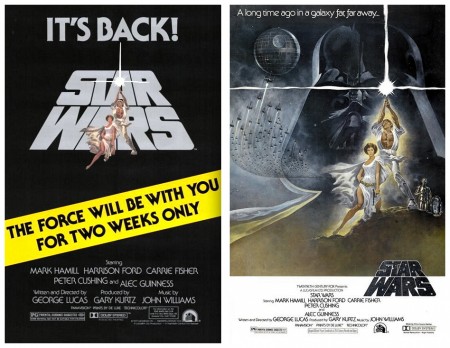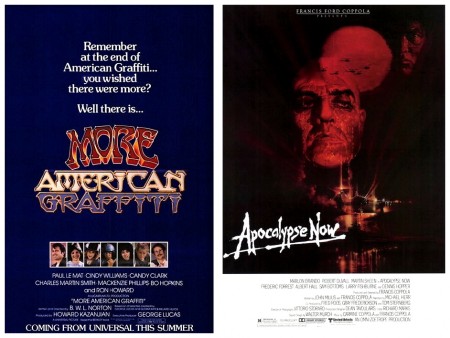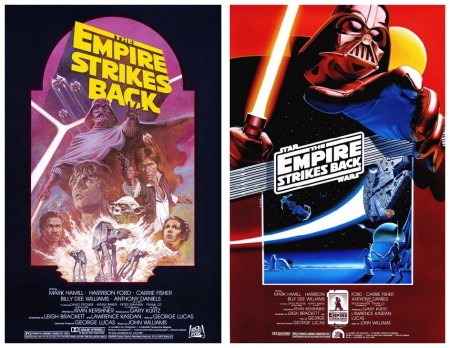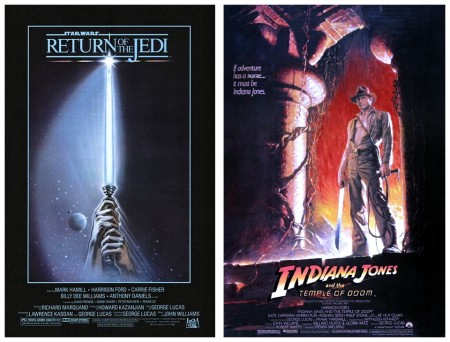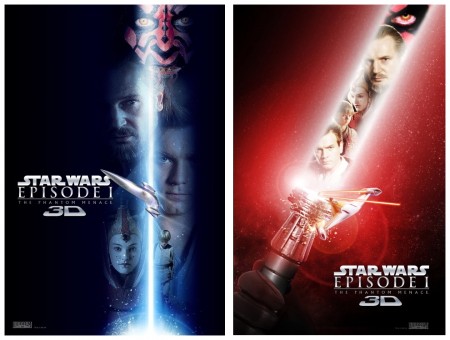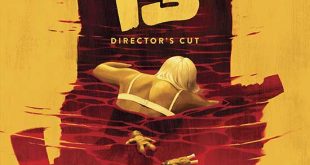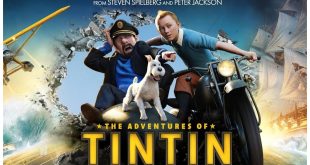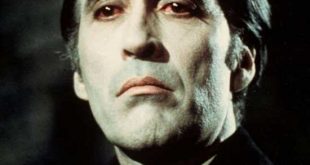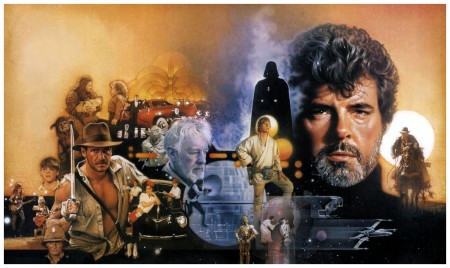 In 1964 a short skinny kid entered film school at the University of Southern California, and fifteen years later he was a multi-millionaire. He was still skinny and shy back then. His name is George Lucas and, for a time, it looked as if his first feature film, THX 1138 (1971) was going to be his last. It was produced by George’s friend Francis Ford Coppola as part of the output of his new company American Zoetrope, of which young George was vice-president. At around that time, George was developing a screenplay about Vietnam – later Coppola asked him to direct it, but George was too busy making Star Wars, so he reluctantly handed the project over to Coppola who made the film himself. It was called Apocalypse Now (1979).
In 1964 a short skinny kid entered film school at the University of Southern California, and fifteen years later he was a multi-millionaire. He was still skinny and shy back then. His name is George Lucas and, for a time, it looked as if his first feature film, THX 1138 (1971) was going to be his last. It was produced by George’s friend Francis Ford Coppola as part of the output of his new company American Zoetrope, of which young George was vice-president. At around that time, George was developing a screenplay about Vietnam – later Coppola asked him to direct it, but George was too busy making Star Wars, so he reluctantly handed the project over to Coppola who made the film himself. It was called Apocalypse Now (1979).
Although THX 1138 has plenty of action, it’s essentially an ‘art house’ film. THX 1138 (Robert Duvall) is a man living in a repressive totalitarian future society where people have numbers, not names, and are kept sedated by drugs so they behave themselves. THX’s female roommate, LUH 3417 (Maggie McOmie), suggests to him that they stop taking the pills and, to THX’s surprise, he starts to feel sexual desire, possibly for the first time in his life. LUH becomes pregnant and THX is imprisoned in a white limbo for punishment. The centre of the movie, visually very intense, is this stark clinical whiteness which seems to absorb the human warmth of all those exposed to it. Fellow prisoners tell THX there is no escape, but he walks out anyway. After outwitting authorities in a bike chase, he reaches a less populated sector of this underground society, where he is attacked by hairy midgets. Then he finds a ladder and climbs to the surface. There he stands, confused and exhilarated, as he faces a blinding sunrise.
There was nothing overly original about George’s screenplay, co-written by Walter Murch. Most of the ingredients were standard stuff for science fiction dystopias, and many of them first appeared almost a century ago in the works of E.M. Forster, Aldous Huxley, H.G. Wells and Yevgeny Zamyatin. Indeed, one reviewer accurately described it as “More Nineteen Eighty-Four than Nineteen Eighty-Four.” But the visual treatment was extremely strong: The bleak sets, the crowds of shaven-head drugged conformists bustling through the corridors, the sex-and-violence television shows to keep the masses quiet. George, a quick learner, took the moral of that film’s failure – do not make films that are bound to appeal to a minority of tastes. George still likes the film, and indeed it remains one of his best, but it hardly made any money, even when it was rereleased at the height of George’s fame.
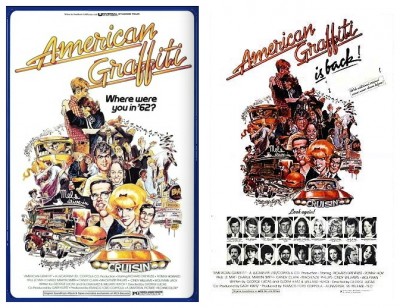 With this major black mark against him, George had trouble selling his next idea, a rock’n’roll movie set in 1962 about bored car-driving teenagers in a small town just like the one he grew up in. Eventually, Universal agreed to back it, and American Graffiti (1973) was released. An excellent film, it was a deserved box-office hit and kick-started a wave of worldwide cultural nostalgia (despite being a very American film), the ripples still felt today. In a then-unique marketing strategy, George insisted on using original songs and artists, the result being an extremely popular soundtrack album which went triple platinum in the USA alone.
With this major black mark against him, George had trouble selling his next idea, a rock’n’roll movie set in 1962 about bored car-driving teenagers in a small town just like the one he grew up in. Eventually, Universal agreed to back it, and American Graffiti (1973) was released. An excellent film, it was a deserved box-office hit and kick-started a wave of worldwide cultural nostalgia (despite being a very American film), the ripples still felt today. In a then-unique marketing strategy, George insisted on using original songs and artists, the result being an extremely popular soundtrack album which went triple platinum in the USA alone.
Things were looking up. Even then, it was not easy for George to get his next project off the ground, as it was obviously going to be very expensive to shoot, and it didn’t resemble any previous Hollywood hit. Universal passed on it, but Alan Ladd Junior at 20th Century Fox took a chance on it. The huge success of the finished film is now history, and the movie itself hardly needs describing. The blend of mythology and science fiction in Star Wars IV: A New Hope (1977) was not accidental. George researched traditional stories very carefully before setting to work, and he was also interested in the work of Carl Jung, the celebrated psychologist who analysed the archetypal elements of myths in relation to our psychic needs.
It never does to underestimate George – he’s not an especially articulate person and, if he’s guilty of anything, it’s commercial shrewdness. This has led some intellectuals to dismiss him as a cunning money-man with an intuition for popular taste. In fact, George is a very conscious craftsman and his successes have not been accidental nor intuitive. Nor are they the result of cold calculation alone. There is a passionate openness about his best work and, for all his slightly blank introverted manner in public and on-camera, it’s fair to suppose on this basis that he is very much a man of feeling. The story of A New Hope is part fairy tale (a princess kidnapped by evil wizard) and part rite-of-passage (young man grows to maturity) and George went to great lengths not to promote the film as pure science fiction. Its opening words – A long time ago, in a galaxy far, far away – sets it up as fantastic rather than futuristic, like a tale told to children. George’s readiness to appeal directly to the child in everyone was perhaps his greatest act of daring – it could have so easily backfired. To eliminate the kind of sexuality he felt might distract attention from the heroic elements of the film, he even had Carrie Fisher tape her breast flat. George was terribly worried during the making of the film, especially since the budget had skyrocketed from US$3.5 million to US$10 million, but it soon became the most successful film ever made, and even today ranks as the 37th highest-grossing film of all time. An essential factor in the film’s popularity was the rousing musical score by John Williams, now widely recognised as the most successful composer in film history.
The really extraordinary outcome was George’s decision to retire from directing at the moment of his triumph, after directing only three films. But he had by no means disappeared from the world of genre films, he had merely changed roles. Firstly, the special effects unit he had set up for Star Wars, dubbed Industrial Light & Magic, continues to play a central role in creating fantastic onscreen miracles in a large variety of films and genres. Secondly, he continued to act as executive producer and writer on his own projects, two of them being the second and third part of the trilogy: Star Wars V: The Empire Strikes Back (1980) and Star Wars VI: The Return Of The Jedi (1983). George wrote the original stories, of course, but by then he realised that he needed help on his screenplays – for one thing, he was no master of dialogue. For The Empire Strikes Back, George commissioned a first draft from Leigh Brackett (a proficient screenwriter and author of a number of excellent space operas) but she sadly passed away from cancer immediately after delivery. The screenplay was revised by an unknown, Lawrence Kasdan, who became an important director in his own right during the eighties with Body Heat (1981), The Big Chill (1983), Silverado (1985), and The Accidental Tourist (1988).
The Empire Strikes Back is a more polished film than Star Wars. It has better dialogue and even more spectacular special effects, but lacks the raw vigour of its predecessor. There is something ever so slightly calculating about it, though it remains excellent entertainment with its striding tauntauns, its implausibly gnome-like guru Yoda, and its Freudian revelation that villainous heavy-breathing Darth Vader is Luke Skywalker’s father. One element missing is narrative thrust, and the film is a little too episodic. Part of the trouble is that, although Star Wars came as a complete surprise, this time audiences knew what to expect. It’s hard to tell whether it would have been a better film if George rather than the efficient Irvin Kershner had directed, but his signature is still visible throughout the film.
Many fans argue which is better, Star Wars or Empire Strikes Back, but few are likely to propose Return Of The Jedi as the best of the trilogy. A certain tiredness seems to have crept in, all too obvious in what is a virtual reprise of the destruction of the Death Star in Star Wars, and the revelation that Princess Leia is actually Luke Skywalker’s sister may have been one domestic revelation too many, although it conveniently freed her for the waiting arms of Han Solo. All of the principal actors had lost their youthful charm with the passing of years, Carrie Fisher looking positively matronly in some sequences. Nevertheless, the film is still excellent value for money, filled with an entertaining variety of grotesque aliens (some looking rather rubbery and digitally replaced in later editions) and an entertaining rocket-propelled speeder-bike chase that is certainly one of the best of its kind.
The invention of a new alien race, the Ewoks, rather gives the game away. The success of the previous two films (and marketing such as clothes, dolls, toys, soap, whatever) had obviously depended heavily on the presence of young children who would nag their parents to take them not once or twice, but repeatedly. The Ewoks, designed to resemble a cross between teddy bears and puppy dogs, are surely a cynical wooing of the kiddie audience, and became the subject of two made-for-television movies – Caravan Of Courage (1984) and The Battle For Endor (1985) – and a short-lived cartoon series. Richard Marquand’s direction of Return Of The Jedi, incidentally, is self-effacing and efficient. On the DVD commentary George explains he chose Marquand because he “had done some great suspense films and was really good with actors. Eye Of The Needle (1981) was the film I’d seen that he had done that impressed me the most, it was really nicely done and had a lot of energy and suspense.” After only four films (including Return Of The Jedi) Marquand sadly passed away in 1987 from a combined stroke and heart attack.
 Even though Return Of The Jedi had disappointed some, there had been ample evidence two years earlier that George’s creative talents were by no means dried up yet. Raiders Of The Lost Ark (1981) was co-produced and co-written by George and directed by Steven Spielberg. It may be the best swashbuckling adventure movie ever made. The interesting thing about Raiders, apart from its intrinsic merits, is that George and Steven seem to have taken it on almost for fun, as a kind of therapy after more elaborate productions. The film is a dazzling and genuine partnership. Planned as a kind of B-grade movie in memory of the great serials of the past, it wound up being comparatively expensive at US$22 million. Harrison Ford is supremely well cast as the unshaven tough-guy hero, quick-thinking and unscrupulous, but his part would not have worked so well without Karen Allen, whose spunky heroine precisely balances it.
Even though Return Of The Jedi had disappointed some, there had been ample evidence two years earlier that George’s creative talents were by no means dried up yet. Raiders Of The Lost Ark (1981) was co-produced and co-written by George and directed by Steven Spielberg. It may be the best swashbuckling adventure movie ever made. The interesting thing about Raiders, apart from its intrinsic merits, is that George and Steven seem to have taken it on almost for fun, as a kind of therapy after more elaborate productions. The film is a dazzling and genuine partnership. Planned as a kind of B-grade movie in memory of the great serials of the past, it wound up being comparatively expensive at US$22 million. Harrison Ford is supremely well cast as the unshaven tough-guy hero, quick-thinking and unscrupulous, but his part would not have worked so well without Karen Allen, whose spunky heroine precisely balances it.
The film is an abject lesson in pacing and editing, piling incident upon incident with superb precision so that the audience would positively gasp at the snowball effect, which continues just long enough to go beyond excitement into wit. The film works so well because it goes very close to being over-the-top but carries off its balancing act and never sinks into parody. Like Star Wars, Raiders Of The Lost Ark caught everyone by surprise, no-one had ever seen anything quite like it before, and was truly breathtaking. Taking a page out of Erich Von Däniken’s book, George envisaged the Ark Of The Covenant as the repository of occult (maybe alien) electrical powers, although the climactic scene in which these powers messily dissolve a slew of Nazis is not the best part of the film. But overall, from Aztec treasures to Egyptian snake-pits, the film remains a wonderfully good-humoured recreation of the pulp adventures of the past, renewing all their fabulous absurdity for another generation. Perhaps George’s greatest strength (maybe Steven’s too) is that he never lost touch with his own adolescence. Raiders Of The Lost Ark is, on one hand, a careful string of effects designed by a couple of knowing millionaires but, on the other hand, it is a film of glowing pristine innocence. This is not really a paradox – with George, the knowingness goes into the craftsmanship, but the innocence resides in the love of the myth itself.
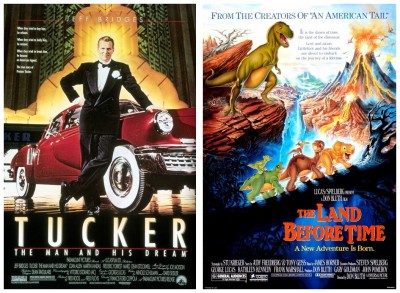 Other notable projects as a producer during the eighties include Akira Kurosawa’s Kagemusha (1980), Lawrence Kasdan’s Body Heat (1981), Jim Henson’s Labyrinth (1986), Godfrey Reggio’s Powaqqatsi (1986), Don Bluth’s The Land Before Time (1988), and Steven Spielberg’s Indiana Jones And The Last Crusade (1989). There were less successful projects too, including More American Graffiti (1979), Indiana Jones And The Temple Of Doom (1984), Howard The Duck (1986), Willow (1988), Tucker: The Man And His Dream (1988) and the 1990 television series Maniac Mansion. As if to make up for the failure of Maniac Mansion, George served as executive producer of the 1992 Raiders Of The Lost Ark spin-off, The Young Indiana Jones Chronicles, providing extremely high production values for one of the best television series ever made. Experienced filmmakers like Simon Wincer, Vic Armstrong, Terry Jones, Mike Newell, Nicolas Roeg and Ben Burtt directed scripts by Jonathan Hales, Frank Darabont, Jonathan Hensleigh, even Carrie Fisher!
Other notable projects as a producer during the eighties include Akira Kurosawa’s Kagemusha (1980), Lawrence Kasdan’s Body Heat (1981), Jim Henson’s Labyrinth (1986), Godfrey Reggio’s Powaqqatsi (1986), Don Bluth’s The Land Before Time (1988), and Steven Spielberg’s Indiana Jones And The Last Crusade (1989). There were less successful projects too, including More American Graffiti (1979), Indiana Jones And The Temple Of Doom (1984), Howard The Duck (1986), Willow (1988), Tucker: The Man And His Dream (1988) and the 1990 television series Maniac Mansion. As if to make up for the failure of Maniac Mansion, George served as executive producer of the 1992 Raiders Of The Lost Ark spin-off, The Young Indiana Jones Chronicles, providing extremely high production values for one of the best television series ever made. Experienced filmmakers like Simon Wincer, Vic Armstrong, Terry Jones, Mike Newell, Nicolas Roeg and Ben Burtt directed scripts by Jonathan Hales, Frank Darabont, Jonathan Hensleigh, even Carrie Fisher!
George was also keeping busy behind-the-scenes so-to-speak. For instance, the cinema sound-system known as THX was founded by George providing stereo, digital and theatrical sound for films and music. Skywalker Sound and Industrial Light & Magic are among the most respected firms in their fields. Furthermore, LucasArts is well-respected in the gaming industry, and the Pixar animation studio started life as a division of Lucasfilm, resulting in groundbreaking effects in films such as Star Trek II: The Wrath Of Khan (1982) and Young Sherlock Holmes (1985), then the group was purchased in 1986 by Steve Jobs shortly after leaving Apple Computers. Jobs paid a mere US$5 million to George and then put another US$5 million into the company itself. What a bargain! For the twentieth anniversary of Star Wars, George went back to his trilogy to enhance and add certain scenes using newly available digital technology. These new versions were released in theatres in 1997 then, for the DVD releases in 2004, the films received even more revisions and tinkering to make them look and feel more like the prequel trilogy. Star Wars I: The Phantom Menace (1999) would be the first film to be directed by George in more than two decades, and followed through with Star Wars II: Attack Of The Clones (2002) and Star Wars III: Revenge Of The Sith (2005).
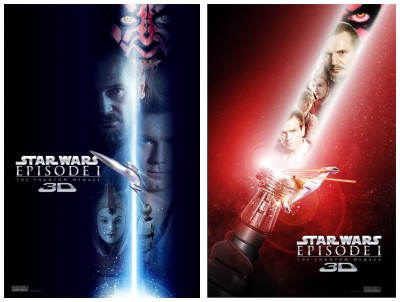 The Phantom Menace concerns Jedi Master Qui-Gon Jinn (Liam Neeson) and apprentice Obi-Wan Kenobi (Ewan McGregor), who escort Queen Amidala (Natalie Portman) from the planet Naboo to the planet Coruscant in the hope of finding a peaceful end to an interplanetary trade dispute. We meet young Anakin Skywalker (Jake Lloyd), a slave boy who seems to be unusually strong with the Force and must contend with the mysterious return of the Sith. Attack Of The Clones takes place ten years later, when the galaxy is on the brink of civil war.
The Phantom Menace concerns Jedi Master Qui-Gon Jinn (Liam Neeson) and apprentice Obi-Wan Kenobi (Ewan McGregor), who escort Queen Amidala (Natalie Portman) from the planet Naboo to the planet Coruscant in the hope of finding a peaceful end to an interplanetary trade dispute. We meet young Anakin Skywalker (Jake Lloyd), a slave boy who seems to be unusually strong with the Force and must contend with the mysterious return of the Sith. Attack Of The Clones takes place ten years later, when the galaxy is on the brink of civil war.
When an assassination attempt is made on Senator Amidala, Jedi apprentice Anakin (Hayden Christensen) is assigned to protect her, while his mentor Kenobi is assigned to investigate the assassination attempt. Soon, Anakin, Amidala and Kenobi are drawn into the heart of the Separatist territories and the beginning of a new threat to the galaxy, the Clone Wars. Revenge Of The Sith takes place three years after the beginning of the Clone Wars. Jedi Knights lead a massive clone army in the war against the separatists. Kenobi is dispatched to eliminate the evil General Grievous (Matthew Wood) and, in his absence, Anakin becomes friends with Chancellor Palpatine (Ian McDiarmid), who also happens to be a Sith Lord. Their deepening friendship proves dangerous for the Jedi, the galaxy, and Anakin himself, who inevitably succumbs to the Dark Side of the Force and becomes Darth Vader.
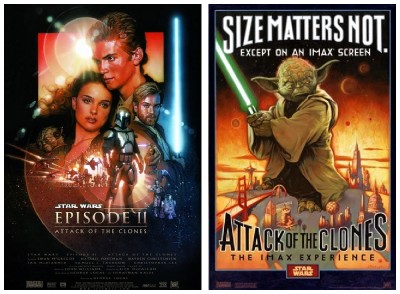 Unfortunately, the audience is shown Anakin as Vader at the conclusion of Episode III which destroys the original concept of the cliffhanger serial. That Vader was Anakin was supposed to be a big surprise but now, when you watch the films in order, the viewer is well-aware that it is Anakin under that helmet throughout A New Hope and The Empire Strikes Back. On the other hand, George would have been lynched by fans if he didn’t at least make a reference to Vader in one of the prequels. Perhaps the most controversial addition to the Star Wars mythos was the introduction of midi-chlorians, microscopic organisms that mediate the Force. Some fans saw it as a concept that negated the spiritual quality of the Force, reducing it to a kind of viral infection.
Unfortunately, the audience is shown Anakin as Vader at the conclusion of Episode III which destroys the original concept of the cliffhanger serial. That Vader was Anakin was supposed to be a big surprise but now, when you watch the films in order, the viewer is well-aware that it is Anakin under that helmet throughout A New Hope and The Empire Strikes Back. On the other hand, George would have been lynched by fans if he didn’t at least make a reference to Vader in one of the prequels. Perhaps the most controversial addition to the Star Wars mythos was the introduction of midi-chlorians, microscopic organisms that mediate the Force. Some fans saw it as a concept that negated the spiritual quality of the Force, reducing it to a kind of viral infection.
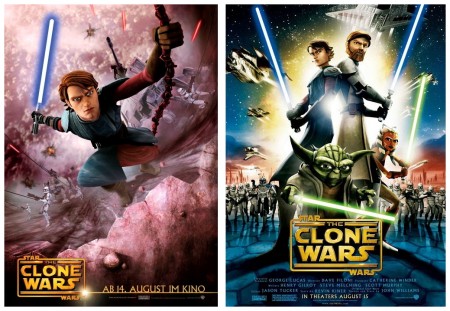 Some saw midi-chlorians as a biological interface, a link between physical bodies and spiritual energy. Despite mixed reviews – great action and visuals, poor writing and performances – the trilogy of prequels are amongst the highest-grossing films of all-time. Some critics claimed they only demonstrate George’s weaknesses as a writer of dialogue, a criticism that George openly agreed with when he accepted the Lifetime Achievement Award from the American Film Institute in 2005.
Some saw midi-chlorians as a biological interface, a link between physical bodies and spiritual energy. Despite mixed reviews – great action and visuals, poor writing and performances – the trilogy of prequels are amongst the highest-grossing films of all-time. Some critics claimed they only demonstrate George’s weaknesses as a writer of dialogue, a criticism that George openly agreed with when he accepted the Lifetime Achievement Award from the American Film Institute in 2005.
After a great deal of pressure from fans, George re-teamed with Steven and Harrison Ford produce Indiana Jones And The Kingdom Of The Crystal Skull (2008). Set in 1957, it pays homage to the B-grade movies of that era, pitting Indiana Jones against Soviet spies in a race for an extraterrestrial crystal skull. Although the plot elements are familiar, the film certainly delivers on the thrills, and the return of Harrison Ford and Karen Allen is more than welcome, but it seems hardly worth the nineteen-year wait.
Much better is Star Wars: The Clone Wars (2008), an excellent and very well-regarded animated television series that takes place between Attack Of The Clones and Revenge Of The Sith. There are a hundred twenty-two-minute episodes planned. Despite negative responses to the pilot episodes (compiled and released theatrically), The Clone Wars has received generally favourable reviews, and may well be the most photo-realistic animated television series ever produced. Looks aside, the stories and character development is of a high quality as well, evidenced in such episodes as Rookies, Cloak Of Darkness, and The Lair Of Grievous.
The influence George has had, not just on genre films but on modern cinema in general, is incalculable. Firstly, by keeping his productions independent he has completely outmaneuvered the intricate structure of Hollywood financing and pointed the way to the final collapse of the old system. Secondly, whether or not you regard Star Wars as the greatest fantasy ever made (and I do not), you must give it credit for encouraging the financing of other influential genre projects at the time that otherwise may never have got off the ground, films as diverse as Alien (1979), The Black Hole (1979), Excalibur (1981) and Blade Runner (1982). If genre cinema was ever going to have a saviour, it looked like George was it but, by shifting its emphasis away from adult complication to childlike simplicity, he may also prove to be its destroyer. With that word of warning I’d like to profusely thank Time magazine, The Evening Standard, The Times, Rolling Stone magazine and Wikipedia for assisting my research for this article, and ask you to please join me next week when I have the opportunity to give you another swift kick in the good-taste unit with a high-speed rocket-powered terror-filled excursion to the dark side of Hollywood for…Horror News! Toodles!
 Horror News | HNN Official Site | Horror Movies,Trailers, Reviews
Horror News | HNN Official Site | Horror Movies,Trailers, Reviews
